Here’s a recap of yesterday’s Duck Day festivities, including recipes, photos, and whatever else I think to include.
Relevant to those new to this blog: corwin has been celebrating “Duck Day” (Thanksgiving) ever since he went to college (M.I.T.) in 1986 and he and his friend Scliff cooked duck instead of turkey because corwin likes duck much better than turkey. Over the decades the meal has evolved along with corwin’s culinary skill. I entered the picture in 1992. In the past 10 years especially the complexity (and execution) of the meal has really ramped up as we keep challenging ourselves, reading books, eating at some of the best restaurants in the world (see previous blog posts about our recent trip to Barcelona…), and studying molecular gastronomy and Science and Cooking.
So, this year with the coincidence of Thanksgiving and Chanukah, I suggested our theme could be Festivals of Lights of various cultures, and we ended up going with: Lantern Festival (China), Festival of Merce (Barcelona), Diwali (India), Thanksgiving (USA), Chanukah (All of Jewdom), Yule (Northern Europe and other cold places).
The prep cooking begins over a week before, when corwin began making stock out of all the duck carcasses and bones saved in the freezer from last year, as well as rendering all the fat from the skins that had been reserved. He also did a ton of shopping. This year’s meal required trips to the Wine & Cheese Cask, H-Mart (the Korean super-grocery), Mayflower Poultry (the “Live Poultry Fresh Killed” place), New Deal Fish Market, Ebisuya Market, Formaggio, and Whole Foods, but a surprisingly large amount of the meal came from our farm shares and our now extremely well-stocked pantry, root cellar, and freezer(s). Two items did have to be ordered from Amazon, though, when we could not find them locally in any Asian groceries! (Wheat starch and a tamago-making pan.)
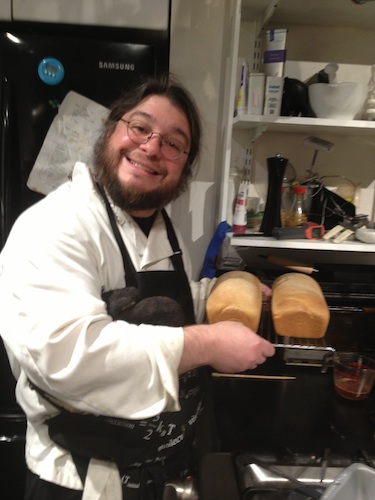
A week in advance corwin put the zukesake to marinate — it’s sushi salmon marinated in sake lees.
Four days before the meal, Scliff and corwin butchered six ducks into parts, separating the breasts out for one course, the thighs for another, the other parts of dark meat for a third, the skins for a fourth. Yes, six ducks will turn into a seven-course meal for 17 guests.
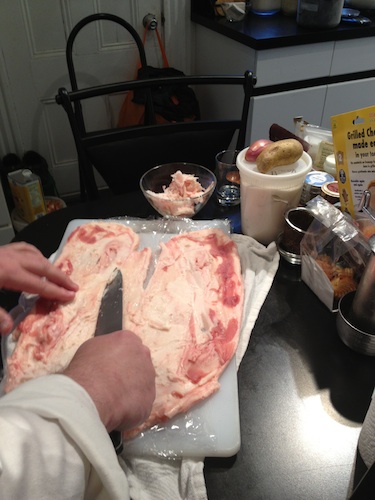
Three days before the meal I spent nearly the entire time I had allotted for prep to making a single dish: the final one. The green tea almond financiers were the only course that was prepared entirely ahead of time.
Two days before the meal we prepped all the sauces: house made chili paste, apple chutney/sauce, garlic aioli, duck jus, gravy, ketchup, etc. (Tip on making aioli that came out of the book Consider The Fork, you know how if you make a classic aioli in the food processor–a la Robuchon–you’re supposed to drizzle the oil in a slow steady stream? You know what’s perfect for that? The food pusher tool that goes into the Cuisinart has a tiny hole in the center. Fill the hollow pusher with oil and it will drizzle out that hole perfectly. Worked perfectly.)
Anyway, to the dishes and how they went:
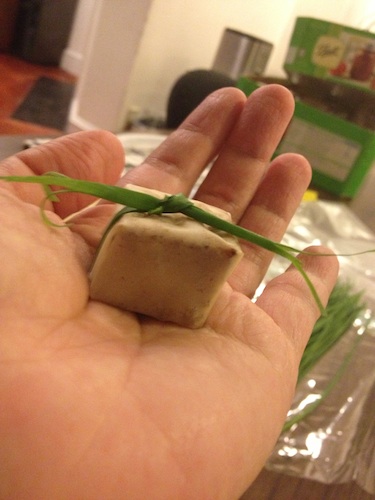
COURSE ONE:
Amuse: Holiday Gift
A zukesake “present” with gari
Wine pairing: Domäne Wachau Grüner Veltiner 2012 (Austria)
Pickling gari (ginger) is not that hard. What we end up with is more intense and fresh-tasting than traditional sushi ginger because we have to use mature ginger, which is what you get in the grocery stores, whereas sushi bar gari is made from “young” ginger. corwin basically looked up gari recipes on the Internet and interpolated (like on japanesefood.about.com and foodpreservation.about.com. Zukesake, sushi salmon marinated in sake lees, also came from a recipe corwin looked up on the Internet and then modified. They serve this now at Blue Fin restaurant in Cambridge and we’ve ben enjoying it there, so wanted to try making some ourselves. The sake lees (the rice sediment left after rice wine sake is made) were actually easy to come by–corwin found them at Ebisuya Markei in Medford. The “Marinade” is actually more of a paste made from mirin, miso, the sake lees, etc. and then pasted onto the fish with cheesecloth. The internet recipe said to use two pounds (!) of sake lees for two pounds of salmon, but that seemed WAY too much. He used 9 ounces, which is what came in a package, and it worked fine.
The idea was to open the meal with a festive gift. I sliced cubes of the salmon and then wrapped them using colorful soy sheets (our sushi chef introduced us to them years ago, now you can buy them easily in Asian groceries). I wrapped them exactly like using wrapping paper, and used a chive for a ribbon. We have one vegetarian guest. For her I fried a cube of tofu and then marinated it all day in soy sauce, sesame oil, and ponzu sauce, and wrapped it the same way.
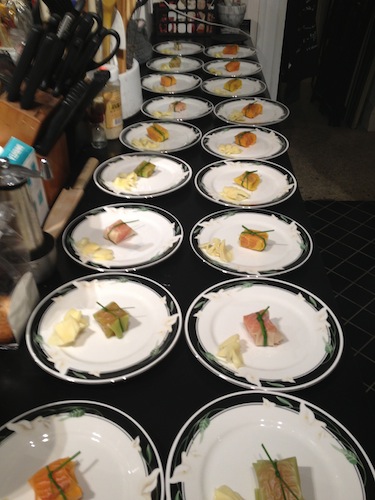
COURSE TWO
Lantern Festival (China): Twin yuanxiao dumplings
Char Siu Duck
Chive & Water Chestnut
Served with house-made chili garlic paste
The white wine served with the amuse was for this course, too. This being duck day, we use duck in most things, so instead of a char siu pork, we made duck in a char siu preparation. Basically the same recipe but with a dash of Worcester sauce instead of oyster sauce (to accommodate kosher eaters). We made yuanxiao dumplings, which are the deep fried football shaped ones you get at dim sum but which according to the book ASIAN DUMPLINGS by Andrea Nguyen are traditional for the new year Lantern Festival. She also says at dim sum they’re often terrible, leaden and greasy. I highly recommend this book. I’ve now made several dumplings out of it that I’d never before attempted at home and all have come out delicious and her instructions on all the fussy things one has to do to get the doughs right are terrific.
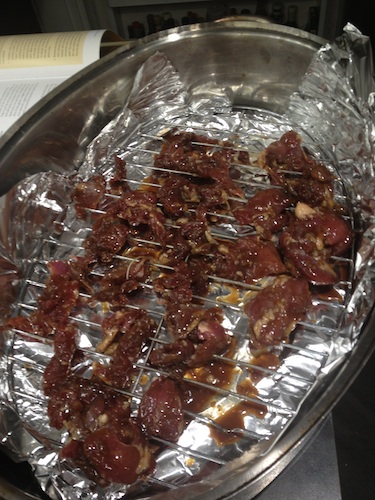
These dumplings have a dough that is made mostly from sticky rice flour, with some wheat starch and shortening, and boiling water. The dough was very soft and non-structural, like super soft Play-Doh. Once I got the hang of it, though, it wasn’t that hard to stuff the dumplings. With more practice I think I will be able to get more filling into each one, but for a first attempt these came out quite good, I thought. The chive version we filled with chinese chives (which are different from western chives, much larger and grassier) and water chestnuts. to make the filling I used a shrimp and chive dumpling recipe (this one from Anyrecipe.net) but left out the shrimp and replaced the bamboo shoot with water chestnuts.
And yes, corwin made his own Sriracha. Actually he didn’t puree it down to sriracha texture, and kept it chunky like the chili paste served in jars on the table in Chinese & Vietnamese restaurants.
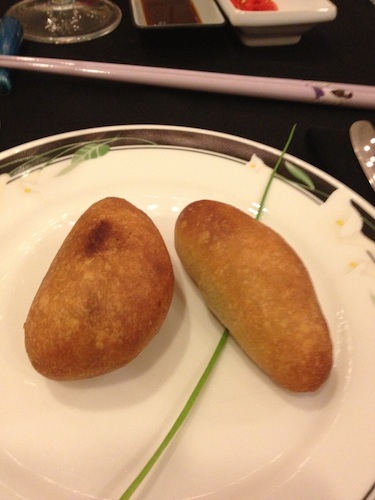
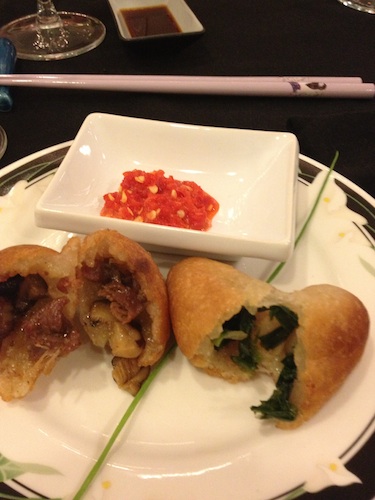
COURSE THREE
Festival of Mercê (Barcelona): Tapas
Duck Ropa Vieja
Cauliflower in saffron batter
Mushrooms • Roasted red and green peppers • Olives
Pan Cubano
Wine pairing: Abel Mendoza Rioja 2012 (Spain)
Of course we paired a rioja with the tapas course. It’s really just lucky for us that Barcelona has a festival of lights to celebrate the saint day of Merce, the patron saint of the city whose day (and night) are celebrated with fireworks and such. We happened to be in Barcelona this year during Merce or we wouldn’t have even known about this.
I had the idea to do a ropa vieja using duck confit. Ropa vieja means “old clothes” and is usually made with beef stewed down until it can be pulled like pork, shredded into strands that look like your rags have disintegrated in the laundry. (But delicious rags.) For the basic flavor profile and ingredient list I used this ropa vieja recipe from Saveur online.
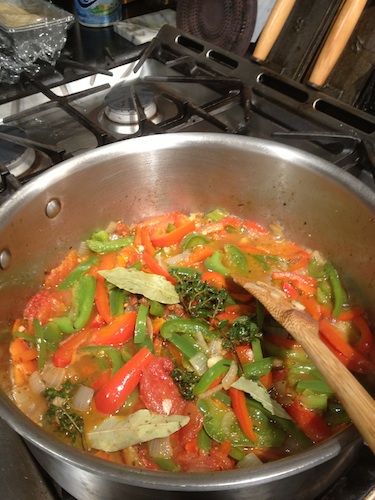
I sauteed all the non-duck ingredients (red and green peppers, onions, for tomatoes I used our house-smoked tomatoes, garlic, cumin, fresh thyme, oregano) into a sofrito, until everything was a little caramelized, then poured in about a quarter cup of wine to scrape up the caramelized bits. Then I poured in the other half bottle of wine. Forget using water or stock or broth, a half bottle of Cava that had gone flat and so was sitting around in the cabinet was perfect. I stewed all that for a while. 45 minutes? An hour? Until the liquid tasted unbelievably amazing. Then I let it cool a bit, shredded the duck confit and removed the bones, and combined the shredded duck with the stewed vegetables. Let it sit overnight in the fridge. The next day to serve it I warmed it up in the oven in a dutch oven while the previous course was being made, plated and served.
The other complex dish in the tapas course is the tamago torta. Torta is a traditional spanish dish made of egg, potato, and onion, often served cold at tapas. We couldn’t just do a traditional one, though: boring. We’re very fond of Asian fusion (some would argue I *am* Asian fusion) so hit upon the idea to do this as if it were tamago, the cold egg sushi. Tamago usually incorporates sweet rice wine: corwin reduced fino sherry instead, and added a core of potato and onion sauteed in smoked spanish paprika. Instead of traditional white sushi rice, he made saffron rice with sushi rice, replacing the mirin with cream sherry and some saffron and annatto oil. I did the assembly, making the sushi balls and slicing the egg crosswise. When he asked me why I put two on each plate, the answer was “one order, two pieces!” (Also, he’d made enough that we had a whole uncut tamago roll left over and I only used about half the rice…) Here’s a tamago recipe reference online.
corwin batter dipped cauliflower and deep fried it. He makes a saffron batter–I’m not sure what’s in it. Scliff roasted the peppers over the gas flame of the stovetop, yum. corwin sauteed a mix of wild mushrooms inspired by this dish in the Mercat de la Boqueria in Barcelona:
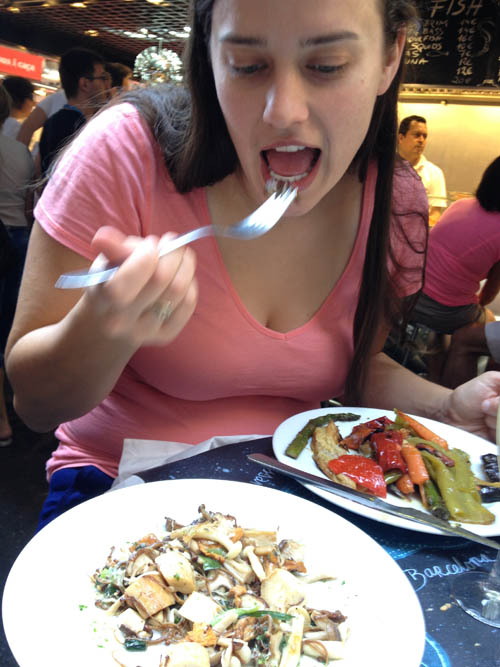
The cuban bread was one of three breads in this meal. (Next course served with Indian naan, and sage bread is used in a later course.) corwin has been using the book Artisan Breads Every Day religiously for over a year now. It completely leveled-up his breadmaking techniques. He combined the usual cuban bread recipe with the techniques in Artisan Breads Every Day and the result was an incredibly soft set of baguette style loaves.
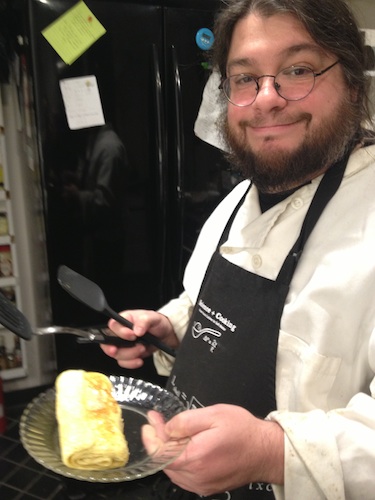
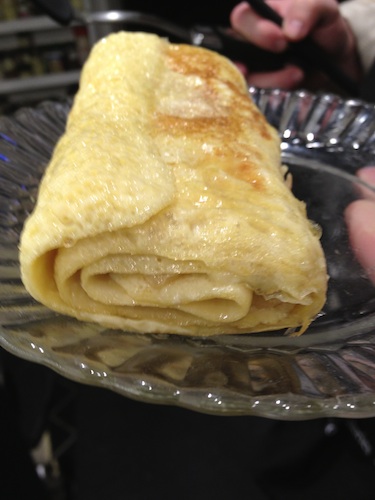
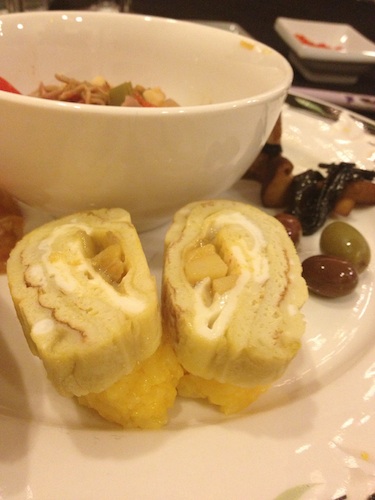
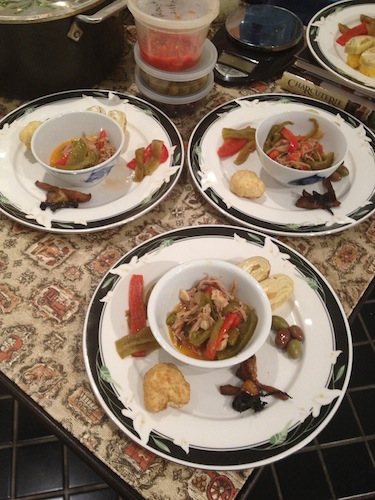
COURSE FOUR
Diwali (India): Dahl
Pureed lentil soup with shrikhand ice cream
Naan
Cocktail: Palate Uncleanser
I made this recipe up by interpolating dal soup recipes on the Internet. Many call for black or red dal. What I had in the pantry was white dal, so I did my test recipe a few weeks back with that, and it was so good, I decided to stick with it. I started with this recipe from Food.com but modified it quite a bit. To activate the spices in Indian food you nearly always want to sauteed them in oil. So I sauteed turmeric, cayenne, cumin, and cardamom with garlic, two finely chopped carrots and a finely chopped large yellow onion. Once everything was soft and beginning to caramelize a little, I added the lentils, a handful of curry leaves, and vegetable stock we’d made from celery, carrots, onions, and random greens we’d been saving in the freezer. (When your farm share gives you more organic veggies than you can eat, you end up freezing a lot of stuff.) The lentils were the Indian kind that have no skins on them when you buy them. Simmer an hour at least. Once everything is pretty much mush, puree until velvet smooth with an immersion blender.
Shrikhand is a sweet saffron yogurt dessert they used to serve at our favorite Indian restaurant, Namaskar, sadly now closed. You could only get the shrikand if you ordered the Gujarati thali, and we would go in there and order the thali just to get that. (Well, and we loved the miniature poori, too.) One time we were telling the waiter how much we loved it and the owner went in back and gave us a frozen quart container of it. That’s how we discovered it’s really delicious as frozen yogurt, too.
My idea with this dish would be it would totally mess with hot/cold sense, both in temperature and in spice. So the soup was served piping hot (lentil really holds the heat) but with a scoop of the hard frozen shrikhand in the center of the bowl, gradually melting. Kind of like how you put a scoop of cold sour cream on mexican black bean soup. The soup was spicy from the cayenne and needed the sweet coolness and mellowing of the frozen yogurt.
It worked perfectly.
Originally we had planned to serve it with the mini poori we love so much, but looking at the overall balance of the menu we decided we had too many deep fried things, so replaced it with naan. It was my first time making naan. I opted to fry-bake it in the cast iron skillet. Came out fantastic. (corwin pulled the naan recipe off the Internet also, from Half Baked Harvest.)
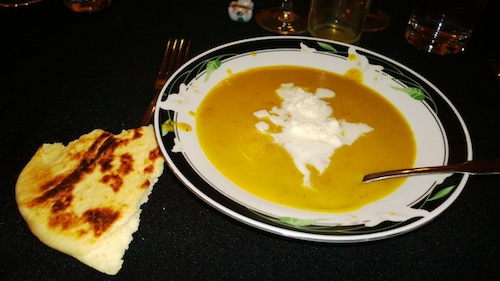
Now, wine pairing with Indian food is almost impossible. Wine just does not go with it. Beer and cocktails, though, go perfectly fine. Partly inspired by the paired cocktails we had when eating at 41 Degrees/41 Grados (the successor to Ferran Adria’s El Bulli), corwin cooked up (literally) what I deemed the “palate uncleanser.” (Traditionally we serve a palate cleanser cocktail at some point mid-meal. This would be the opposite, though.) It was warm rather than cold, and he made people guess what it was. Guesses ranged from eggnog to yogurt to milk. It was actually almond milk steeped with cardamom, turmeric, cinnamon stick, gloves, ginger, sugar, and Licor 43 (a vanilla liqueur). It was everything that we love about eggnog, but suitable for the lactose intolerant.

COURSE FIVE
Thanksgiving (USA): “Leftovers”
Open faced sandwich of roasted duck breast
on sage bread with sweet potato, gravy, and spherified cranberry sauce
Wine pairing: Domaine Zind Humbrecht Gewurtztraminer 2011 (Alsace)
So, the joke with this course is that we’ve never actually MADE a “traditional” American Thanksgiving dinner for Duck Day. But you know the classic open face sandwich? I wanted to do a take on that but which would blow away the usual. The base layer was the sage bread corwin baked. On top of that I put a layer of mashed sweet potato. Want to know what I did to make the sweet potato so good? NOTHING. We got orange sweet potatoes from our farm (Red Fire Farm in Granby, Massachusetts). If you haven’t heard about why the root vegetables in New England taste so fantastic, look up the definition of Brix Score. Short answer: cold weather = veggies concentrate nutrients and sugar = flavor. The sweet potatoes we get, if roasted at 400, make their own caramel. I mean, the caramel oozes out of them as if injected there. (This fact will be relevant later in the dessert course.) Anyway, I brushed them with olive oil and stuck them in the oven for an hour or so. When it was time to serve I pulled the loose skins off, sliced the interior, and then mashed the slice against the bread with my chef’s knife. That was literally all it took to make “mashed” sweet potatoes.
Then a layer of gravy. corwin made a very rich (but not dark-looking) gravy, using the fond from the giblets, duck stock, and whatever else struck his fancy. On top of that, three slices of duck breast prepared sort of how Alton Brown suggests, brined in blood orange juice for several hours, then steamed, before being finished in a cast iron pan in the oven.
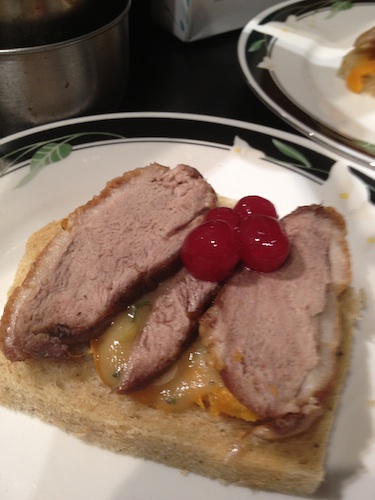
Atop the sliced duck breast, the cranberry. These are reverse-spherified, by mixing the cranberry and blood orange juice with gluco (calcium gluconate) and xantana (xanthan gum) and dropping into an alginate bath. (Molecular gastronomy instructions online at khymos.org and MolecularRecipes.com. First attempt: the juice was still too watery and didn’t cohere in the bath, so corwin mixed in more xanthan gum. We overshot and they were a little too blobby to make perfect spheres, but they came out pretty good visually and taste-wise were perfect. Blood orange was a great juice to mix with cranberry juice, adding some body and sweetness but keeping the brilliant red color.

A little extra gravy on the plate to soak into the bread. The results were fantastic. And we served it with what is for us the “traditional” Thanksgiving wine pairing, a Gewurztraminer from Alsace we’ve been serving for years.
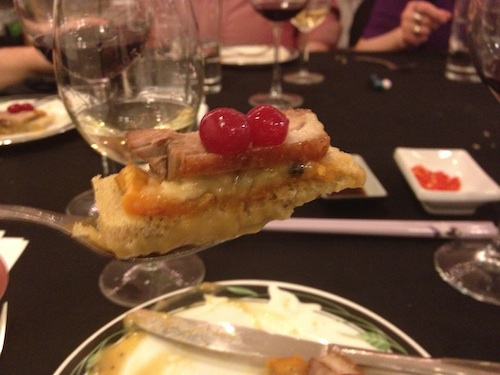
INTERMEZZO
Palate Cleanser of carbonated black gyokuro tea with ginger-lemon grass-lime ice
Now for the actual palate cleanser. The black gyokuro is a very flavorful,full-bodied tea I bought at David’s Tea in Greenwich Village with a flavor profile similar to some of the black yunnan teas. I brewed it, corwin carbonated it, and he made the ice by making ginger lemongrass syrup and freezing it in ice cube trays.
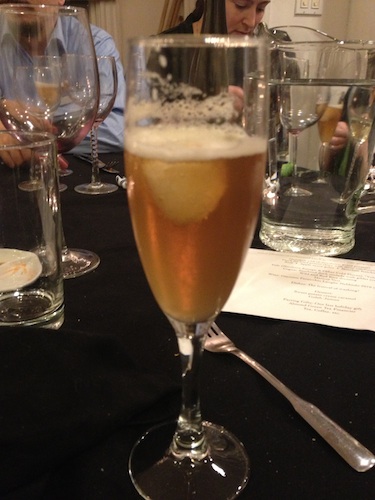
COURSE SIX
Hanukah (All of Jewdom): Fried potatoes
Duck fat fried potato chips with three condiments:
Äioli • Apple sauce gelée • Bourbon Ketchup
Okay, so it’s Chanukah, which is where the idea for this theme came from, but corwin (who is the Jewish one of us), said there isn’t really much in the way of traditional Hanukah foods. Fried jelly donuts and fried potatoes are about it, and the frying in oil is the symbolic traditional thing. Well, we had several deep fried elements already (both dumplings, the battered cauliflower, we nixed the poori… a dessert to come…), but we decided we had to have one here. So duck fat fried potato chips served with three homemade sauces. The apple gelee was basically an apple chutney corwin pureed and thickened, aioli is the traditional garlic mayonnaise, and bourbon ketchup is something we invented a few years ago when taking a left turn while trying to make barbecue sauce. Delicious. I couldn’t decide which of the three sauces came out better. I kept trying them in turn. Then I ran out of potato chips.
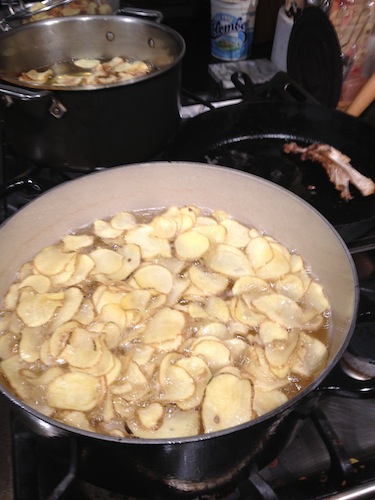
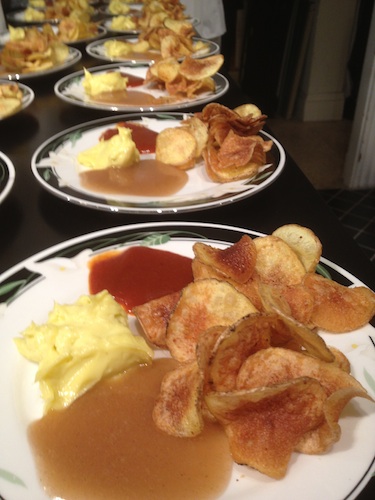
COURSE SEVEN
Yule (Northern Europe & Other Cold Places): “Yule Log”
Cognac flambeed duck roulade with giblet jus
Wild and Red Rice dressing
Haricot Vert
Wine pairing: Giacomo Fenocchio Langhe Nebbiolo 2010 (Italy)
The finale of the savory courses! The idea was to make a yule log out of two duck roulades, flambee it at table (because Yule logs should be on fire), and then slice it to serve it. corwin dressed it up with some mushrooms (real ones, not meringue ones like on a buche de noel), and while he flambeed it with cognac, I “served” rosemary smoke to the table by lifting a glass dome I had filled with flamed rosemary. Damn that smells good.
The wild rice and red rice dressing was a mix of those two grains with toasted almonds, currants, and sauteed aromatics (carrot, onion, parsley). The haricots verts were lightly steamed. All of it was doused liberally with duck giblet jus.
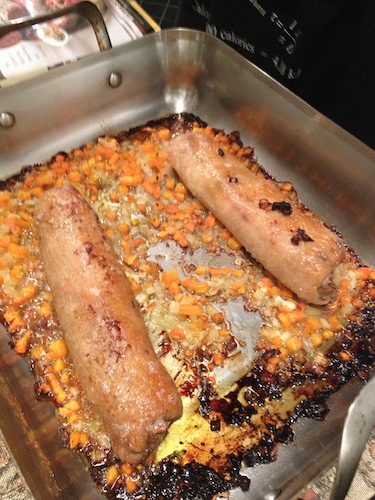
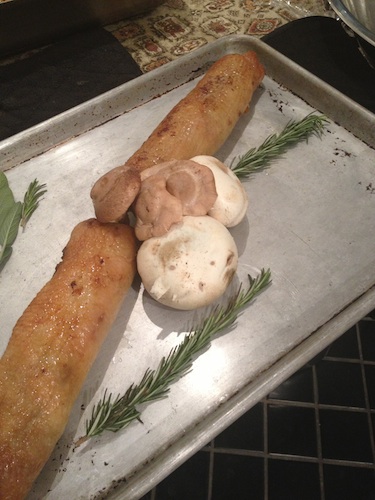
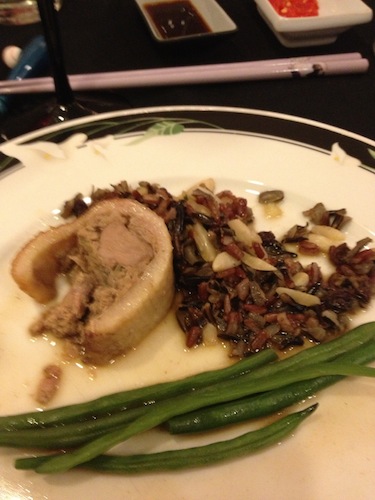
COURSE EIGHT
Dessert:
Sweet potato creme caramel
Gulab Jamun
Parting Gifts: One last holiday gift: Almond Green Tea Financier
Tea, Coffee, etc.
At last we come to the sweets. Since these are not a particular holiday themselves we picked things that seemed to thematically echo earlier courses.
Sweet potato creme caramel was based on this recipe from Food 52, but I made some modifications. (Of course.) In particular I cut the cointreau to a third, and I roasted the sweet potatoes at 400. Remember what I said above about how they make their own caramel? If you only do them at 300 degrees for 30 minutes, like this recipe says, they don’t do that. I tried it and they were soft but unspectacular. I put them back in for another 20 minutes at 425 to get some great brown caramel leaking out of them. Yes, that results in some hardened dried bits of the edges of the potatoes, but that’s okay because this recipe is STRAINED. I also beat the eggs pretty thoroughly. The recipe says “lightly beaten.” Okay, so not until frothy, but you still have to get all the white and yolk mixed or I think it’ll turn out eggy. This did not turn out eggy. It turned out the best flan ever.
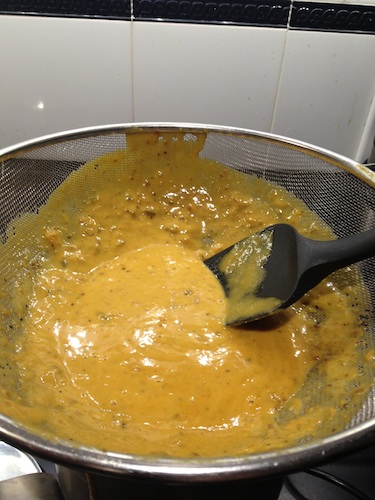
I was using a big flan mold that I got from my mother’s garage sale before she moved to Florida like ten year ago. Somehow I never used it until this meal. I had to double the recipe to make enough to fill the pan pictured.
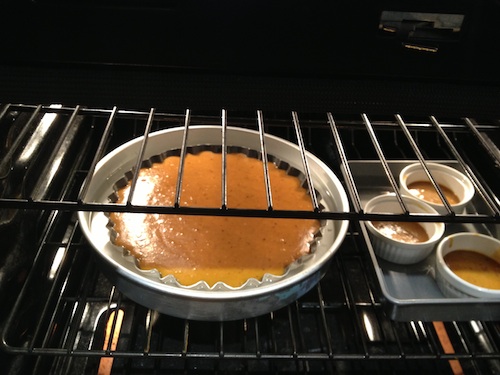
I made one error while taking it out of the oven when it was done–some of the water from the bain marie got into the flan pan. I poured it off and the flan doesn’t seem the worse for wear at all. The next day it unmolded perfectly–perhaps the water even helped with that?
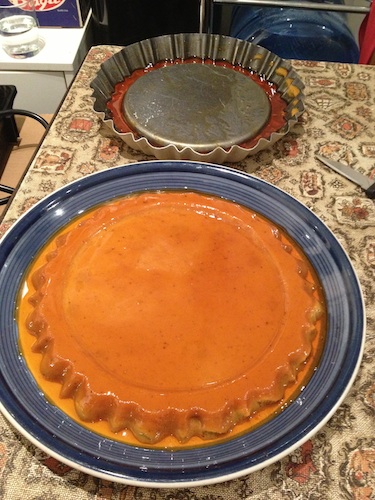
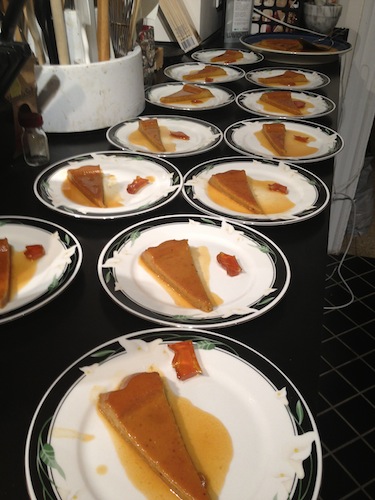
Gulab jamun. corwin decided to make gulab jamun in keeping with the fried donuts theme. What we didn’t know until looking up the recipe is what they’re made of! I always thought they were just fried dough. No, the “dough” is mostly nonfat dry milk, mixed with cream. No wonder our lactose intolerant friends feel ill when they eat them!
And let me tell you, fresh made gulab jamun are NOTHING like the soggy sad things they serve cold in Indian restaurants around here.
The drawback to fresh made hot gulab jamun is they take an hour to make. Several guests had to throw in the towel and leave before we could get dessert on the table. (We had sat down to eat at 8:30pm, a half hour behind schedule, but it was after midnight when we served course six, and about one in the morning when corwin started cooking the gulab jamun…)
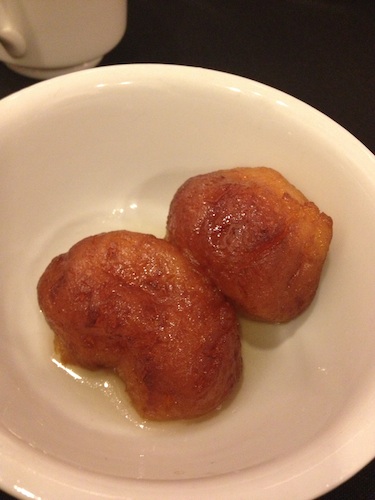
Slow, but delicious. The gulab jamun recipe also came from the fantastic ASIAN DUMPLINGS book previously mentioned.
Everything was topped off at the end with a parting gift, echoing the opening amuse, an almond green tea financier/petit four in the same shape and size as the zukesake had been.
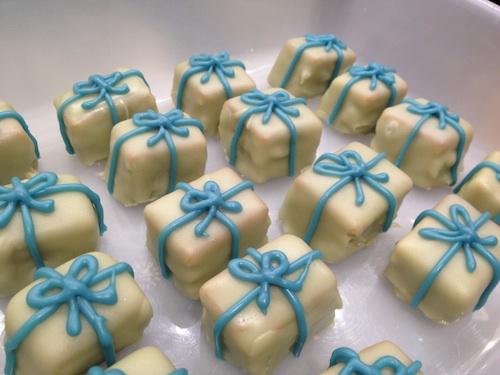
I’ve made these before, but I finally hit on a recipe that I actually like. The reason these took a whole day to make: it’s really two recipes, one for the cakes and one for the icing, and the decoration is time-intensive also. And also the icing recipe I tried first was a complete failure and I scrapped it and did a second method. As follows:
Financiers/Petit Fours
I’ve been playing around with different recipes for these for a while, sometimes using coconut flour while trying to make a gluten free version, etc… adding brown butter, and so on, but here’s what I settled on. I started with this basic recipe for “Brown Butter Pistachio Financiers” from Food & Wine, but using a cup of almond flour (Bob’s Red Mill) instead of the pistachios. And instead of making them in molds I bake a single 9×9″ square pan and cut them into squares for the petit four treatment.
Also after baking, cool the whole square in the pan, then unmold it, flip it over in the pan, and brush liberally with Amaretto. I used about a quarter cup of amaretto and I could have easily used a half cup. (I was finishing what was left in a bottle.) Let it soak in well before you try to cut into squares. This will be a very solid cake. (Which is the point.) For the petit fours I trim the edges off and eat them as a snack, and only use the nice even edged cubes I cut.
Icing
For the record, the petit fours icing recipe that failed was from the Land o Lakes website (here) and was 3 cups sugar, 1/4 teaspoon cream of tartar, 1 1/2 cups water, 1 cup powdered sugar, sifted, 1 teaspoon almond extract or vanilla, 3 drops food color, if desired. It involved making a sugar syrup first, then adding the powdered sugar last. The resulting icing was far too thin and had an unpleasantly gritty mouthfeel despite sifting and even after much stirring, waiting, etc.
Also, I discovered that using the Penzey’s double-strength vanilla and the Trader Joe’s organic powdered sugar results in an icing that is too beige to be used “as is.” If you want a really nice white petit four you need a whiter sugar and no vanilla (perhaps almond extract is colorless). To hide the drabness I added a drop of blue food coloring and that looked nice, but the icing was still too thin.
Rather than try to fix that one by putting more powdered sugar in, since it seemed too gritty, I started over with another recipe, this one from KitchenKrafts.com. I halved the recipe, actually, since it calls for two pounds of powdered sugar and by that point I only had one pound left. And I wasn’t trying to make 50 petit fours. I only needed 17 (one per person) but figured I’d make 20-25. (25 cuts nicely out of the cake: 5×5. I actually ended up cutting 6×6 and had lots of left over un-iced to eat as snacks. Spread Nutella or peanut butter or TJ’s cocoa almond spread on them!)
Anyway. So 4.5 cups of powdered sugar, a blob of corn syrup, and a quarter cup of water, THAT’S IT! Well, okay, it was still beige. I separated out a half cup to decorate with, and to the main batch I added one drop of green food color and then some matcha powder to give it a little green tea flavor and color and that made it a lovely light sage green color. The part I separated out I added three drops of blue food color to make the ribbons with.
This had to be heated over the double boiler a couple of times during use, but generally the trick was finding the right consistency (viscous but not TOO thick or it eats the cake), dipping the whole piece of cake on a fondue fork until submerged in the slow-moving icing, and then pulling it slowly out, fully coated. Place on a cooling rack and pull the fondue fork gently free and then immediately “spackle” the fork holes with an icing knife. After the icing hardens, break the dripped “feet” off by running the icing knife under the petit four.
I did all the coating first and then after they were good and hardened, did the ribbon decorations. The right tool for this turned out to be a small condiment squeeze bottle (made by Wilton’s)which I could microwave for 5 seconds any time the icing got too thick to go through the nozzle. It was way cleaner and easier than trying to handle a pastry bag and piping tip. I’m never going to use a pastry bag (or the pre-made “writing icing” tubes from the grocery) again!
Voila. That was it. I served a lichee black tea with the gulab jamun that made it seem like a rose tea because the rose notes in the black tea were brought out by the rose water in the gulab jamun syrup. corwin made coffee that he had roasted himself earlier in the day. And then we sat around talking until three in the morning.
It’s now 2:16 in the morning the NEXT morning, and the house is finally clean. By the way, the only way we keep up with the dishes and such is that in between every course, while we’re frantically cooking the next course, guests get up and do a round of dishes. They keep everything moving! Otherwise, forget it, by the third or fourth course we’d be on paper plates. We use pretty much every dish in the house and sometimes even the silverware has to go multiple times through the dishwasher. Thank goodness for the Bosch dishwasher whose “quick” cycle can be as quick as 30 minutes when the water is hot!
Next year… we’ll do it all again Except different. Who knows what theme we’ll think up?

Holy cow, that all looked amazing!
It tasted even more amazing! 🙂